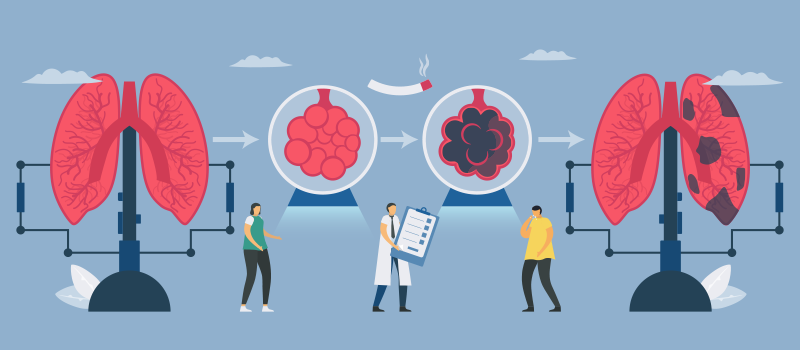What’s the Buzz
The Bee Healthy Blog
What Are the 4 Stages of COPD?

Some 16.5 million Americans have chronic obstructive pulmonary disease (COPD). This is a progressive disease that gets worse over time, but it is treatable. With the proper management, most patients with COPD can achieve symptom control and have a good quality of life.
Continue reading to learn more about the four stages of COPD, how they are classified, and what it means in terms of symptoms and treatment.
What is chronic obstructive lung disease COPD?
COPD is a chronic inflammatory condition of the lungs that causes obstruction of airflow. It is caused by long-term exposure to irritants such as environmental pollutants and cigarette smoke. Symptoms can include shortness of breath, cough, wheezing, and sputum (mucus) production. Two lung conditions that frequently co-occur with chronic obstructive pulmonary disease are chronic bronchitis (inflammation of the air passages) and emphysema (a condition in which the air sacs in the lungs are destroyed).
COPD is classified into four stages by the Global Initiative for Chronic Obstructive Lung Disease (GOLD), an international organization that develops COPD treatment and care guidelines.
What are the four stages of COPD?
The GOLD system for COPD classifies the disease based on various factors, including:
- The patient’s symptoms and their impact on quality of life
- The patient’s risk of having flare-ups (exacerbations or sudden worsening of symptoms)
- The patient’s spirometry results (test to assess how well the lungs are working)
Based on this assessment, COPD is labeled with a number from Grade 1 to Grade 4 and a letter from Group A to Group D. The GOLD system gives healthcare professionals a great deal of valuable information on monitoring and treating a patient’s COPD. In the following paragraphs, we will give you some more information about the four stages of COPD.
GOLD Grade 1 to Grade 4
The grade of COPD tells doctors about the degree of airflow obstruction in the lungs. This is measured by a spirometry test, which is a type of lung function or breathing test. It essentially evaluates how well you inhale and exhale (breathe air in and out of your lungs).
A machine called a spirometer is used to measure two values called the forced vital capacity (FVC) and forced expiratory volume in 1 second (FEV1). FVC is the total volume of air you can blow out at a time. FEV1 is the amount of air you can blow out in the first second of a hard or forced exhalation. People with COPD have a low FEV1 for age. A diagnosis of COPD is made if the FVC/FEV1 is less than 70%. Four stages of COPD are graded depending on the spirometry results.
- GOLD System Grade 1 (mild COPD) FEV1 of 80% or more
- GOLD System Grade 2 (moderate COPD) FEV1 of 50-79%
- GOLD System Grade 3 (severe COPD) FEV1 of 30-49%
- GOLD System Grade 4 (very severe COPD) FEV1 less than 30%
The GOLD grade is not the only thing doctors use to decide which COPD treatment is appropriate, such as lifestyle changes, oxygen therapy, pulmonary rehabilitation, or lung transplant. They also consider symptoms, the chances of COPD flaring up, and other health conditions, if any.
GOLD Group A to Group D
Doctors additionally stage COPD into Groups A to D based on a patient’s symptoms and the risk of having a flare-up.
COPD Exacerbations
Patients who have had two or more exacerbations (flare-ups) in the past year, whether they needed hospital care or not, are considered at high risk of COPD exacerbations. Those who have not had any flare-up in the past year or had one flare-up that did not require hospital care are considered low risk for COPD exacerbations.
COPD Symptoms
When a patient is medically reviewed, a doctor may ask them to complete a short questionnaire about their symptoms and quality of life. The two questionnaires that are most commonly used to assess COPD progression are the COPD Assessment Test or CAT and the Modified MRC Dyspnea Scale or mMRC.
CAT asks patients to rate symptoms such as shortness of breath, cough, phlegm, chest tightness, sleep, mood, activities, and energy. The total score on this test is 40.
- A CAT score of 5 or less is expected in a healthy person who doesn’t smoke.
- A CAT score of 10 or less indicates few COPD symptoms.
- A CAT score of 10 or more indicates more symptoms.
The mMRC measures breathing difficulties on a 4-point scale. An mMRC score of 0 to 1 indicates more minor COPD symptoms. An mMRC score of 2 or more indicates more symptoms.
Once a doctor has these results, they combine them to label the COPD according to the GOLD assessment system and provide medical advice, diagnosis, and treatment accordingly.
- GOLD Group A: Low risk of flare-up and fewer symptoms
- GOLD Group B: Low risk of flare-up and more symptoms
- GOLD Group C: High risk of flare-up and fewer symptoms
- GOLD Group D: High risk of flare-up and more symptoms
What do the GOLD grade and group mean?
The GOLD grade and group tell healthcare providers what stage COPD you have. This information, along with your other medical problems, determines the management plan for your COPD. Doctors adjust the treatment plan depending on your response to treatment and whether your COPD worsens over time.
Keep in mind that every patient is different. For instance, a patient with severe COPD who has a CAT score of less than 10 and no flare-up in the past year will be classified as Grade 3 Group A. Another patient with moderate COPD who has a CAT score of less than 10 but three flare-ups in the past year will be classified as Grade 2 Group C. Sometimes doctors may need to order additional tests, such as lung function tests or a CT scan, if there is a significant difference between the grade and group (for example, if a patient has Grade 1 Group D GOLD stage). This helps the doctor figure out what’s going on with COPD and plan pulmonary rehabilitation accordingly.
What are the symptoms of the four stages of COPD?
As mentioned, every patient is different and can experience different symptoms of COPD even if they have the same GOLD stage as another patient. In general, COPD progresses as follows:
Stage 1 (mild COPD)
There may be no symptoms or mild symptoms such as a nagging dry cough or a small amount of phlegm. Patients also might experience shortness of breath with exercise, which is often put down to being “out of shape.” Younger patients commonly do not notice any symptoms until they’re in their 50s.
Stage 2 (moderate COPD)
There can be a persistent cough and phlegm, worsening breathing problems, wheezing, fatigue, and sleep problems. In addition, around 20% of people with this stage of COPD have flare-ups with changes in phlegm color. There can also be mood changes, confusion, and other impacts on mental health.
Stage 3 (severe COPD)
This stage of COPD is associated with worsening symptoms such as chest tightness and wheezing, even with daily tasks. In addition, some patients develop ankle and leg swelling. There is also an increasing number of flare-ups and chest infections.
Stage 4 (very severe or end-stage COPD)
Patients in this stage of COPD usually have worsening and persistent symptoms, with normal breathing becoming an effort. End-stage COPD symptoms may also include crackling sounds when you breathe, fast or irregular heartbeat, pulmonary hypertension, weight loss, delirium, and barrel chest. Flare-ups also become more severe and frequent.
Is COPD a terminal illness?
COPD is a terminal illness. However, many patients with this condition have other medical problems and do not die of COPD directly.
How long can you live with Stage 4 COPD?
It is impossible to predict a COPD patient’s life expectancy because many factors come into play. Treatments including pulmonary rehabilitation can help people with COPD live longer with a better quality of life. However, in general, patients with COPD have an increased risk of mortality compared to healthy individuals.
In people with no history of smoking, COPD causes only a modest reduction in life expectancy. However, there can be a reduction in life expectancy by 5 years or more in former smokers and current smokers.
References:
1. https://www.lung.org/research/trends-in-lung-disease/copd-trends-brief/copd-prevalence
2. https://www.mayoclinic.org/diseases-conditions/copd/symptoms-causes/syc-20353679
3. https://www.lung.org/lung-health-diseases/lung-procedures-and-tests/spirometry#











SOCIAL